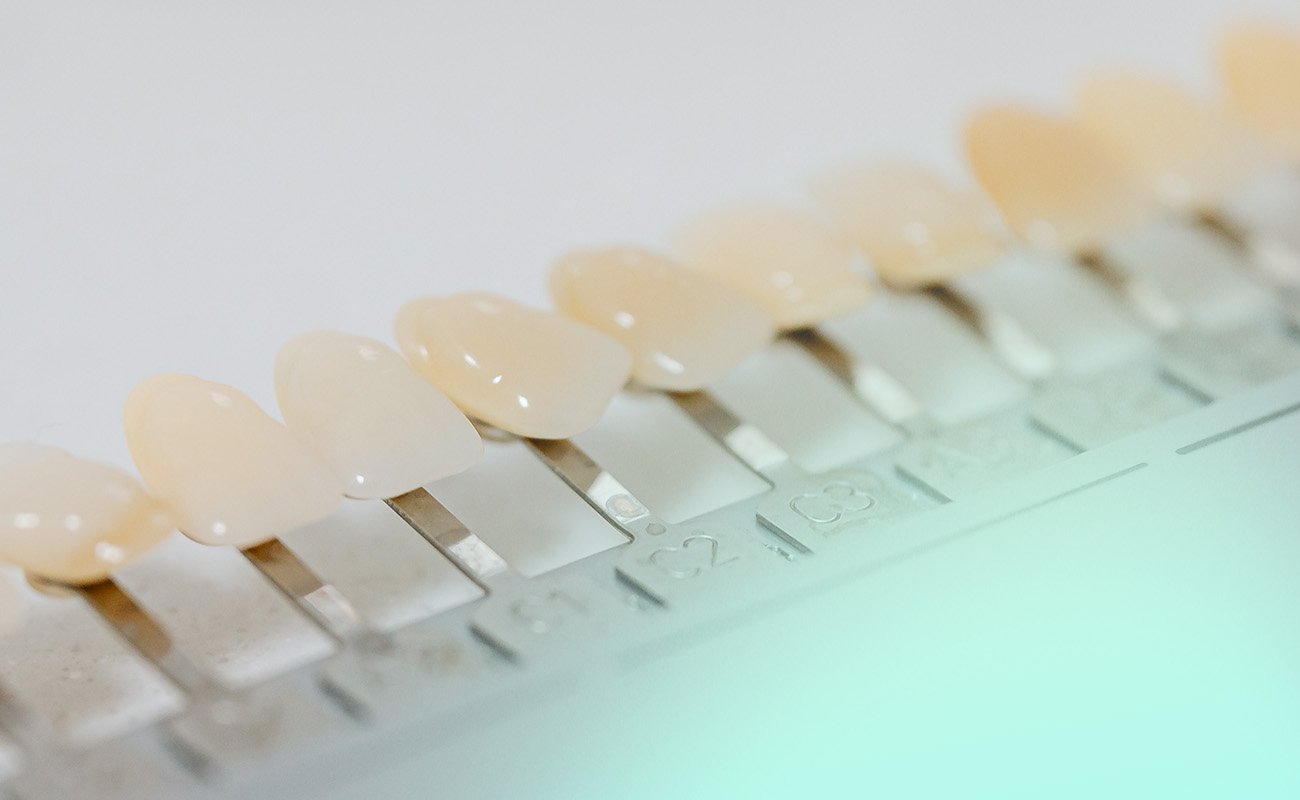When considering dental treatments, it can be difficult to decide which option is best for you. Issues like cost, length of treatment, and effectiveness all factor into the equation. Both aligners and veneers are effective options with their own set of benefits and disadvantages depending on your individual needs.
In our “Aligners vs Veneers” comparison, we’ll explore the difference between aligners and veneers, two ever-growing treatments for a variety of cosmetic dental concerns. From discussing the cost of treatment to exploring how long each procedure takes, we will cover everything you need to know before making your decision.
Aligners
Aligners are an alternative to traditional braces and they offer a more discreet and nearly invisible method of achieving straighter teeth with minimal impact on day-to-day life.
Using a transparent, customized plastic material, aligners fit closely over the surface of your teeth like a shell and gently direct them into the desired position within weeks or months. The process of using aligners starts with dental impressions or digital images being taken of your mouth which will create an overview of the situation that can be used to create the aligners to fit precisely. A series of personalized aligners are then created specifically for you that are designed to shift your teeth over time gradually.
The greatest advantage of wearing aligners is that they are virtually invisible to other people, which can give them an edge over traditional braces in terms of discretion and aesthetics. In addition, they are generally more comfortable than braces since they don’t have any sharp edges or wires.
Aligners should be worn consistently for a minimum of 20 hours per day; however, they can be conveniently removed when eating, brushing, and flossing, allowing for easy cleaning and maintenance, unlike traditional braces. They can also be taken out for meals and important events, making them a particularly attractive choice for adults.
Aligners are an effective treatment option for a variety of dental irregularities. They can be used to correct overcrowding, excess spacing between teeth, gaps, crossbite, overbite, underbite, and mild to moderate cases of a misaligned jaw. In comparison with metal braces, they do not offer as precise control over the direction and speed at which they move teeth; however, they typically require less frequent dental appointments than braces due to their straightforward design.
See our article: Clear Aligners – Before and After.
Veneers
Veneers are wafer-thin shells made of durable, tooth-colored materials such as ceramic or composite resin, which are permanently bonded to the front surface of a tooth to improve its appearance. They can be used to treat and hide minor defects like chips, discoloration, cracks, and misalignments of the teeth, restoring an attractive smile.
The procedure of getting veneers typically requires a consultation followed by two additional appointments: one for preparation and one for placement. During the first visit, a dental professional will take impressions of the patient’s teeth so that customized veneers can be made from them. On the second visit, a small portion of the enamel from each prepared tooth will be etched, thereby forming a tight bond for permanent adhesion. The veneers will then be fixed onto each tooth and properly adjusted until a perfect fit is achieved.
The advantages of veneers are numerous; these include an improved aesthetic appearance with minimal effort required by the patient in comparison to other alternatives such as braces or crowns that may require months or even years of treatment time. Also, since veneers are quite durable and resist staining over time, they provide long-lasting results with minimal maintenance once treatment has been completed.
As with most medical treatments, there are certain precautions to consider when having veneers added to your teeth. Veneers are a solution to cover up an issue with gaps in the teeth rather than combating the issue itself and because existing enamel needs to be etched off before placement this can cause temporary sensitivity after treatment due to lack of protective coating on the affected area.
See our article: Teeth Veneers Pros and Cons.
Worth Knowing
The study published in the Journal of Dental Research shows that patient factors, rather than dentist-related factors, significantly influence the longevity of porcelain veneers. It was found that 53% of these veneers remained intact and did not require any re-intervention for up to 10 years.
What is the Cost of Treatment?
When it comes to deciding to have treatment with aligners or veneers, the cost can be a major factor in your decision.
With veneers, the first thing to note is that this type of treatment is not always covered by insurance because they are often considered a cosmetic procedure. In general, the cost expectation of porcelain veneers is around $800 to $2,500 per tooth. Veneers made of composite materials range from $250 to $1,500 per tooth.
Aligners can cost anywhere from $1,000 to $8,000. The cost of clear aligners depends mainly on the length of treatment required, the brand chosen, and also the type of aligners required (night use, traditional, etc).
There are more likely to be special promotions available from aligner providers too so the costs can be even lower at certain times of the year.
See our articles: Cheaper Option to Veneers and Ways to Save Money on Aligners.
Aligners vs Veneers – Treatment Time
For veneers, there are three main stages of the treatment plan: consultation, tooth preparation, and placement. Overall the whole process should be completed within 3-4 weeks.
The consultation appointment will cover tooth examination to ensure that veneers are the correct choice. This process is normally a general examination to check for any pre-existing issues such as gum disease, tooth decay, or infection. At the preparation appointment, your dental professional will scrape a small amount of enamel off the teeth and take a solid impression to send to the laboratory that will make your veneers. A temporary veneer will be placed on the teeth to protect them until the fitting occurs. The final stage is the placement of the veneers where they are bonded to the teeth. Bonding cement is used to secure the veneers in place and tools are used to remove any excess cement.
Aligner treatment time is dependent on the severity of the issue that needs attention. For very mild cases it is possible to only need treatment for six months, whereas for more severe cases, such as heavily crowded teeth, it can take up to two years.
As an average aligner treatments are normally completed within 12 to 18 months, with the actual duration of treatment depending on a variety of factors, including the complexity of the case, the patient’s compliance with the prescribed treatment plan, and how quickly their teeth respond to the aligner treatment. Patients must wear their aligners consistently and as directed to ensure that the treatment progresses as planned and to minimize any potential delays in treatment time.
See our article: Quickest Way to Straighten Teeth.
Can You Get Aligners While Having Veneers?
You can indeed opt for aligners even if you have veneers, blending the aesthetic enhancements of veneers with the orthodontic benefits of aligners. This combination is particularly appealing for those looking to not just enhance the look of their teeth but also correct their bite. Sometimes, achieving the perfect smile goes beyond surface-level improvements, requiring a mix of restorative techniques alongside aligner therapy.
Veneers are great for concealing misalignments, brightening discolored teeth, and reinforcing fragile enamel. However, for a fully corrected bite and optimal tooth positioning, aligners or braces might be necessary in addition to veneers, ensuring both the health and beauty of your smile are addressed.
For those already sporting veneers, aligner treatment remains an option. But for those considering both treatments, it’s generally recommended to start with aligners to perfect your teeth’s alignment before adding the finishing touch with veneers.
Worth Knowing
The research published in Medicine indicates that the integration of orthodontics with porcelain laminate veneers for the anterior teeth’s aesthetic restoration not only enhances their visual appeal but also reduces the proliferation of oral microorganisms.
Which One to Choose?
If you’re considering ways to improve the appearance of your teeth, you may be wondering whether veneers or aligners offer the better option. Veneers are great for covering up any chips, discoloration, or misshapen surfaces of existing teeth, and can drastically improve the look of a smile.
On the other hand, aligners are a good choice if your main focus is on straightening misaligned or crooked teeth, with the application being minimally invasive and convenient. Aligners offer a more cost-effective solution to teeth straightening than other treatment types too. You can learn more about choosing the best aligner for you and read customer reviews here:
Byte – Our pick, this is the best option for affordability and comes with a lifetime guarantee. A teeth whitening kit and HyperBite are included free with every purchase.

Byte
An affordable option with refundable impression kits, free HyperByte, and a Byte for Life guarantee.
Check out Byte AlignersNewSmile – A budget option that is very affordable and offers superior aesthetics too. Each purchase comes with a free retainer and teeth whitening kit.

NewSmile
Affordable at-home treatment with positive reviews offering superior look and comfort.
Check out NewSmile AlignersUltimately, it all comes down to personal preference as both treatments provide different advantages; it’s important to weigh up your own needs before making any decisions so that you can make an informed decision that brings satisfactory results.
Frequently Asked Questions
How Long After Invisalign Can I Get Veneers?
It is best to wait at least six months before getting veneers following Invisalign treatment. This is because the final result from Invisalign takes some time to settle before proceeding with any other cosmetic dentistry.
Veneers should only be applied to a stable bite, otherwise, the results could be damaged leading to more issues down the line. Furthermore, it may also depend on your orthodontist’s recommendation depending on your particular case.
Can I Get Invisalign When I Have Veneers?
It is possible to get Invisalign treatment even if you already have veneers. Generally, it is important to note that your orthodontist will need to assess the stability of your existing veneers before any Invisalign treatment plan is established.
If your veneers are deemed secure enough, the Invisalign process will likely proceed as usual; however, when you have Invisalign fitted with veneers, you should take extra precautions to avoid any accidental damage.
Should I Have Veneers or Aligners First?
The key to successful veneers is preparing the teeth with aligners first. Aligners will deal with any issues regarding straightening and moving the teeth before an assessment can take place on whether veneers are still required.
Sources
Burke, F. J. T., Lucarotti, P. S. K., Ten-year outcome of porcelain laminate veneers placed within the general dental services in England and Wales; J Dent, 2009. DOI: 10.1016/j.jdent.2008.03.016. Available online at: https://pubmed.ncbi.nlm.nih.gov/18538912/
Ke, Y. et al. A comparison of treatment effectiveness between clear aligner and fixed appliance therapies. BMC Oral Health. 2019. doi: 10.1186/s12903-018-0695-z Available online at: https://www.ncbi.nlm.nih.gov/pmc/articles/PMC6343314/
Khosravi R, et al. Management of overbite with the Invisalign appliance. Am J Orthod Dentofacial Orthop 2017;151:691e699.e2. Available online at: https://pubmed.ncbi.nlm.nih.gov/28364892/

